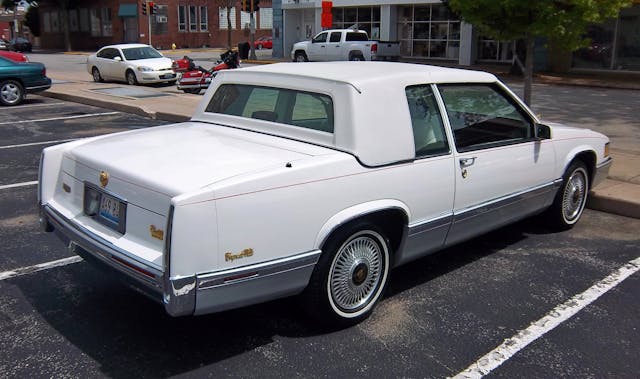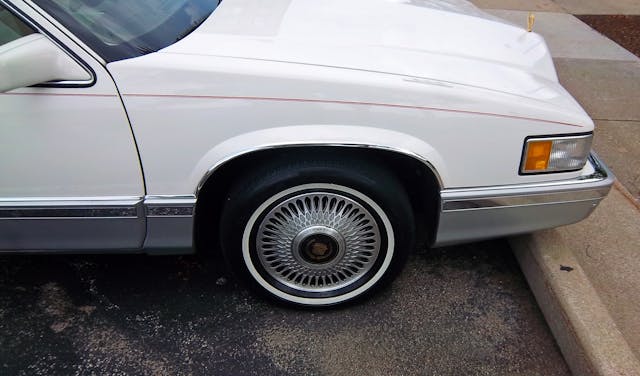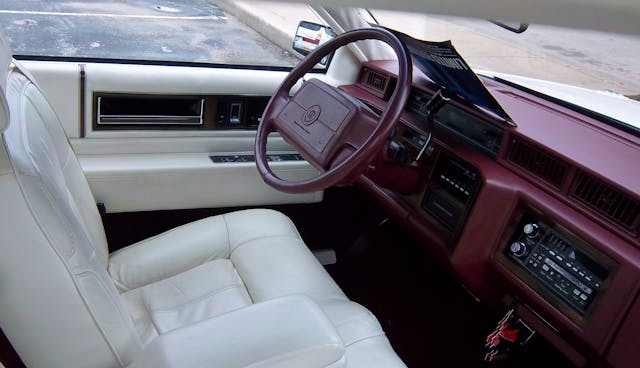1991 Cadillac Coupe de Ville: Triple White Dessert

One of the best things about classic cars is that there’s something for everyone. No matter what one’s tastes are, odds are you’ll find something to love. Fast and sporty? Porsche 911. Classic American luxury? Lincoln Continental convertible. Bizarre and cool? Citroën DS. Just plain weird? AMC Pacer. But regular readers know that your author is frequently smitten with domestic luxury cars, particularly Cadillac and Lincoln. And so here we have a time-capsule early ’90s Caddy for your reading enjoyment today.

This ’91 is an example of the last generation of Cadillac Coupe de Ville. A classic nameplate and frequent style leader in American two-door luxury motoring from its inception in 1949 through the final ones in 1993. While the final downsized C-body Coupe de Ville is perhaps not the best remembered, or most beautiful of them all, they still had Cadillac Style in abundance, at least for the early ’90s.

These ’89-’93 CDVs started with the newly downsized, newly front-wheel-drive 1985 Cadillac de Ville and Fleetwood. These earliest versions were somewhat austere compared to the luxury parade float style of the 1980-84 de Villes, but contrary to some folks’ memories, these rapidly reduced FWD C-body Cadillacs sold well from the get go. By 1986, wider rocker moldings and an available Cabriolet roof improved the luxury look, for those who sought it.

A mild stretch to the rear quarters for 1987, along with composite headlamps and new checkerboard grille, gave the Coupe de Ville, Sedan de Ville and Fleetwood d’Elegance a more modern and slightly larger appearance. Finally, in 1989 a heavy restyle of the 1985 shell made them much more palatable. Pricier Fleetwoods (still available as both a coupe and sedan) had newly added fender skirts and an available Giugiaro-designed Sixty Special interior with 22-way power seats.

Longer flanks, new front and rear styling, an updated interior and other refinements gave the Coupe de Ville a much more imposing look. A steel top was still available, but rarely seen. Most buyers went for either the Cabriolet roof (a landau top with electroluminescent opera lamps and opera windows) or the carriage roof seen on our mint example here.

In addition to the white leather with red trim seen here, white with navy blue was also available for the nautical-minded, as well as a “tuxedo” interior: white with black instrument panel and black carpet. Dark red, navy blue, light yellow (in its last year for ’91), black, tan, dark auburn and light gray were also offered. Such choices! And Cadillac still offered rear ashtrays for rear passengers. Also note all the little Cadillac details: chrome trim, woodtone trim, assist straps, and little Cadillac emblems all over the interior, like on the courtesy lamps on the C-pillar. I love stuff like that. Throwback, perhaps, and likely a little out of date by 1991, but all these little things are what make a Cadillac a Cadillac to me.

I drove several of these in the late ’90s, when they were still commonly seen. My favorite was a gunmetal gray ’93 Sedan de Ville I tried out at Bob Eriksen Chevrolet. The dark red leather interior was heavenly. I loved the interiors on these. The space, the smell of the leather, it was all so Cadillac. They rode great too. And the glass area! Yeah, you used to be able to see out of your car without seventeen cameras and annoying computer beeps.

And by the way, was this one a pristine example or what? I was at the annual Railroad Days car show in Galesburg, IL back in June of 2014 and while walking a couple blocks away from the show to photograph some neat old buildings, I came upon this mint Coupe de Ville. And it was triple white, which for those of you new to Broughamism, means paint, top and interior are all color-keyed in white. I immediately locked onto the target.

It was for sale too, with an ask of $8500 at the time. Showroom condition, low mileage, excellent color combination. Hmm. Nah, I didn’t need another car! But that certainly didn’t stop me from admiring it.

While the 1989-90 versions had a lower, checkerboard-style grill, ’91s received a bigger, redesigned grille combined with a new ‘power dome’ hood. There was more power to back up the redesign too, for beneath the hoods of new de Villes and Fleetwoods (as well as Sevilles and Eldorados) was an updated version of the 4.5-liter V8 used since 1988 (itself a major re-do of the 1982-87 4.1L V8), now upsized to 4.9 liters. The Coupe de Ville now had a quite healthy 200 horsepower with 275 lb-ft of torque. With standard anti-lock brakes and P205/70R15 Michelin tires, these cars could stop as easily as they could get up and go.

Never forget that, downsized or no, these were still Cadillacs, so a long standard features list was expected. Dual comfort 45/55 split front seats, six-way power driver’s seat, Esteem knit cloth (leather was an option), Delco AM/FM/Cassette with six speakers and five-band graphic equalizer, power antenna, electric rear window defroster, heated power mirrors, cruise control, power door locks, leather-wrapped steering wheel, cornering lamps, and 15-inch cast aluminum wheels with whitewall tires were all standard.

That last item threw me a bit–the wire wheel covers cost MORE than the alloys! I VASTLY prefer the alloys to to the wire wheel discs, though they were certainly popular with Cadillac owners. However, the lacy-spoke ones on today’s car were a different style from the ones fitted as standard equipment.

Here’s what the standard alloys looked like–though still MUCH better than the wires in my opinion. The Sedan de Ville remained popular, but by the late ’80s, Coupe de Ville sales were trending downward. The last ones, virtually identical to this one, were built in 1993.

Still, it outlasted its FWD C-body coupe siblings by a healthy margin, as both the Buick Electra/Park Avenue and Oldsmobile Ninety-Eight Regency coupes were last sold in 1987. But in 1991, you could still have your Cadillac Style in two-door Coupe de Ville luxury…for a while.

